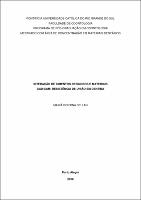| Share record |


|
Please use this identifier to cite or link to this item:
https://tede2.pucrs.br/tede2/handle/tede/7197Full metadata record
| DC Field | Value | Language |
|---|---|---|
| dc.creator | Bellan, Mariá Cortina | - |
| dc.creator.Lattes | http://buscatextual.cnpq.br/buscatextual/visualizacv.do?id=K4305561Y5 | por |
| dc.contributor.advisor1 | Mota, Eduardo Gonçalves | - |
| dc.contributor.advisor1Lattes | http://buscatextual.cnpq.br/buscatextual/visualizacv.do?id=K4705811J8 | por |
| dc.date.accessioned | 2017-03-28T16:52:20Z | - |
| dc.date.issued | 2016-11-29 | - |
| dc.identifier.uri | http://tede2.pucrs.br/tede2/handle/tede/7197 | - |
| dc.description.resumo | O objetivo deste estudo foi avaliar a resistência de união (μTBS) dos novos materiais CAD/CAM a diferentes cimentos resinosos. Trinta e duas coroas foram usinadas utilizando materiais CAD/CAM (Vita Mark II, Vita Suprinity, Vita Enamic and Lava Ultimate) e cimentadas à dentina hígida, utilizando diferentes cimentos (Relyx ARC, Relyx Unicem 2 and Relyx Ultimate). As espécimes foram mantidas em umidade relativa de 100% a 37ºC por 24 horas e após seccionadas em palitos com disco diamantado em água corrente. As amostras (n=16) com área de aproximadamente 1 mm² foram submetidas ao teste de microtração através de uma máquina universal com velocidade de carregamento de 0.5 mm/min. As amostras foram analisadas por MEV para determinar o modo de falha. Os dados foram analisados por meio do ANOVA de dois fatores e do teste Tukey (α=0,05). A resistência de união foi significantemente afetada pelo material e pela interação deste com os cimentos resinosos (p=0.001). Os valores de μTBS variaram de 12.17 para Mark II com Relyx ARC e 32.93 para Lava Ultimate com Relyx Unicem 2. Considerando o comportamento geral dos materiais testados, Vita Enamic (29.39 Mpa) e Lava Ultimate (28.42 Mpa) obtiveram os maiores valores de μTBS em comparação ao Vita Mark II (13.13 MPa) e o Vita Suprinity (14.55 MPa). Os valores de μTBS para Vita Enamic não diferiram estatisticamente daqueles obtidos com Lava Ultimate (p=0.845) e o mesmo ocorreu com Vita Mark II e Vita Suprinity (p=0.986). Não houve diferença estatística entre os cimentos resinosos (p=0.176). Uma união promissora pode ser alcançada com os materiais CAD/CAM híbridos à estrutura dentária e a diferentes cimentos resinosos após 24 horas de armazenamento em água. | por |
| dc.description.abstract | The aim of this study was to evaluate the bond strength (μTBS) of novel CAD/CAM restorative materials to different luting cements. Thirty two crowns were milled using CAD/CAM materials (Vita Mark II, Vita Suprinity, Vita Enamic and Lava Ultimate) and luted to sound and fresh cutted dentin using different cements (Relyx ARC, Relyx Unicem 2 and Relyx Ultimate). The specimens were stored in relative humidity of 100% at 37ºC for 24 h and, then sectioned into sticks with water-cooled diamond blade with low-speed cutting saw. The samples (n=16) with cross-sectional areas of approximately 1 mm² were submitted to tensile bond strength test in a universal testing machine with crosshead speed of 0.5 mm/min. The samples were analyzed with SEM to determinate the failure mode. Data were analyzed using 2-way ANOVA and Tukey’s test (α=0,05). Bond strength was significantly affected by the material and interaction between them and luting cements (p=0.001). The μTBS (MPa) values ranged from 12.17 for Vita Mark II with Relyx ARC and 32.93 for Lava Ultimate with Relyx Unicem 2. Considering overall behavior of tested materials Vita Enamic (29.39 MPa) and Lava Ultimate (28.42 MPa) obtained higher μTBS values in comparison to Vita Mark II (14.14 MPa) and Vita Suprinity (14.55 MPa). The μTBS values for Vita Enamic did not differ from those obtained with Lava Ultimate (p=0.845) and the same occurred with Vita Mark II and Vita Suprinity (p=0.986). There was no statistical difference between cements (p=0.176). A promising bonding performance can be achieved with the hybrid CAD/CAM restorative materials to tooth structure and to different types of luting cements after 24h of water storage. | eng |
| dc.description.provenance | Submitted by Caroline Xavier ([email protected]) on 2017-03-28T16:52:20Z No. of bitstreams: 1 DIS_MARIA_CORTINA_BELLAN_COMPLETO.pdf: 860689 bytes, checksum: 3064d16c5e82cf67605dedf74fd70f61 (MD5) | eng |
| dc.description.provenance | Made available in DSpace on 2017-03-28T16:52:20Z (GMT). No. of bitstreams: 1 DIS_MARIA_CORTINA_BELLAN_COMPLETO.pdf: 860689 bytes, checksum: 3064d16c5e82cf67605dedf74fd70f61 (MD5) Previous issue date: 2016-11-29 | eng |
| dc.description.sponsorship | Coordenação de Aperfeiçoamento de Pessoal de Nível Superior - CAPES | por |
| dc.format | application/pdf | * |
| dc.thumbnail.url | http://tede2.pucrs.br:80/tede2/retrieve/167649/DIS_MARIA_CORTINA_BELLAN_COMPLETO.pdf.jpg | * |
| dc.thumbnail.url | http://tede2.pucrs.br:80/tede2/retrieve/168358/DIS_MARIA_CORTINA_BELLAN_PARCIAL.pdf.jpg | * |
| dc.thumbnail.url | http://tede2.pucrs.br:80/tede2/retrieve/180178/DIS_MARIA_CORTINA_BELLAN_COMPLETO_SUBSTITUIDO.pdf.jpg | * |
| dc.language | eng | por |
| dc.publisher | Pontifícia Universidade Católica do Rio Grande do Sul | por |
| dc.publisher.department | Faculdade de Odontologia | por |
| dc.publisher.country | Brasil | por |
| dc.publisher.initials | PUCRS | por |
| dc.publisher.program | Programa de Pós-Graduação em Odontologia | por |
| dc.rights | Acesso Aberto | por |
| dc.subject | MATERIAIS DENTÁRIOS | por |
| dc.subject | CIMENTAÇÃO (ODONTOLOGIA) | por |
| dc.subject | RESISTÊNCIA DOS MATERIAIS (ODONTOLOGIA) | por |
| dc.subject | ODONTOLOGIA | por |
| dc.subject.cnpq | CIENCIAS DA SAUDE::ODONTOLOGIA | por |
| dc.title | Interação de cimentos resinosos e materiais CAD/CAM : resistência de união em dentina | por |
| dc.title.alternative | Interaction of luting cements and CAD/CAM materials : microtensile bond strength in dentin | eng |
| dc.type | Dissertação | por |
| Appears in Collections: | Programa de Pós-Graduação em Odontologia | |
Files in This Item:
| File | Description | Size | Format | |
|---|---|---|---|---|
| DIS_MARIA_CORTINA_BELLAN_COMPLETO_SUBSTITUIDO.pdf | MARIA_CORTINA_BELLAN_DIS | 840.52 kB | Adobe PDF |  Download/Open Preview |
Items in DSpace are protected by copyright, with all rights reserved, unless otherwise indicated.




